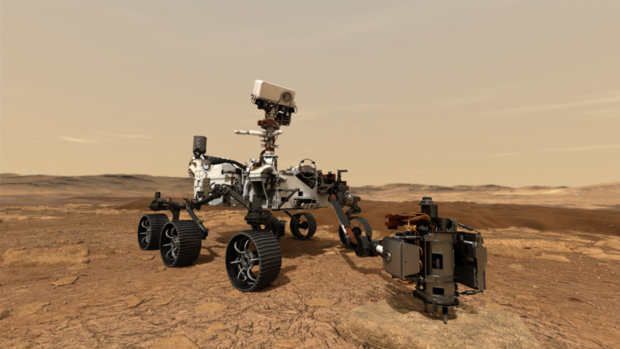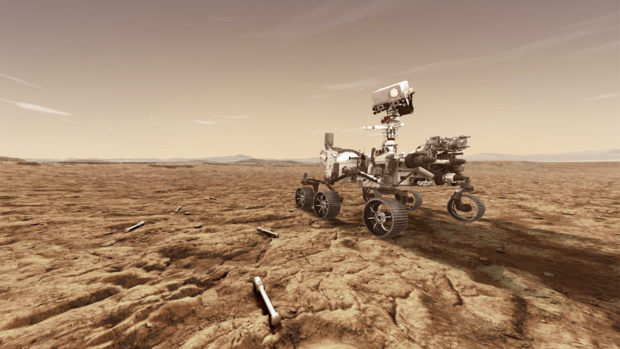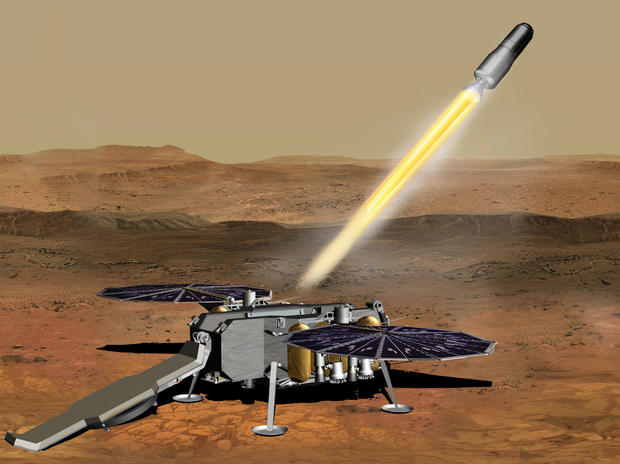▶ Watch Video: NASA’s Perseverance rover completes ambitious Mars landing
NASA’s Perseverance rover successfully pulled off its hazardous landing on the surface of Mars — but more unprecedented challenges lie ahead. A decade from now, in 2031, it will be the first ever to send samples from the red planet back to Earth.
The plan, known as Mars Sample Return, or MSR, involves three missions spanning the next 10 years.
“The idea of bringing a sample back from Mars goes back decades,” Ken Farley, the mission’s project scientist, said in a statement earlier this month. “We are in a position now where if everything goes according to plan, samples will be coming back to Earth in 2031. That sounds like a long time, but this becoming a reality has always been 10 years away since I was in grad school. Now we are actually doing it.”
In many ways, Perseverance resembles its older sibling rovers: Opportunity (2004), Spirit (2004), Sojourner (1997), and Curiosity (2012). But Perseverance is larger and heavier, and scientists have replaced its on-board laboratory with a sample-catching system to collect rocks and soil and prepare them for the return trip.
Never before have scientists brought a piece of another planet back to Earth.
Where are the samples coming from?
Perseverance landed at the edge of the Jezero Crater, a landscape that has long intrigued scientists but had previously been deemed too risky to land on. The crater is believed to have once contained a massive lake, billions of years ago when Mars had liquid water on its surface.
“Scientists will be looking for rocks that may have formed in water, possibly preserving evidence of the chemical building blocks of life,” Lori Glaze, the director of the NASA Planetary Science Division, said in a news briefing last month.
Jezero has a well-preserved river delta, which formed when a river deposited a large amount of sediment as it emptied into a larger body of water. Life flourishes in river deltas on Earth — scientists are hoping the same was true on ancient Mars.
“Jezero would have been a place that was habitable,” Farley said. “Life as we know it could have lived in that lake, and the mud of a delta is really good at preserving the biosignatures of life.”
“It’s not just about the sample, it’s about the geologic context of that sample that will also be explored,” Thomas Zurbuchen, NASA’s director of science operations, said in a news conference Wednesday.
Collecting pieces of Mars to send home
Perseverance will obtain samples using a drill bit, which cuts cylindrical cores into the Martian surface, over the course of about two years. Cores provide researchers with a cross-sectional view of the layers and other features of the rock.
The rover will recover about 40 cores from the ground, each weighing about a half an ounce, or about the size of a piece of chalk. It will triple-seal them into sample tubes to keep them in pristine condition. And the next step is something a bit unusual: It will set them down on the Martian surface, and leave them there.
“After we drill them, we do something that seems crazy: We set them on the ground in what we call a cache,” Farley said. “In the next two parts of the program, we go get them and bring them back.”
In either 2026 or 2028, NASA will launch a Sample Retrieval Lander to Mars, in partnership with the European Space Agency. It will be carrying both a rover and a rocket, known as the Mars Ascent Vehicle.
After it lands at Jezero in 2028, the “Martian dune buggy” will speed across the surface, retrieve the cores left behind by Perseverance and load them into the rocket. Once sealed, the rocket will prepare for the first launch ever attempted from another planet.
The rocket will take off from the surface of Mars and drop a container about the size of a basketball, containing the samples, into orbit around the red planet.
“Much like the baton in a relay race, this container is the heart of sample return,” Bobby Braun, director for planetary science at the Jet Propulsion Laboratory, explained in a news conference.
To complete the handoff, another spacecraft will also make the long journey to Mars’ orbit. The massive Earth Return Orbiter, which is as large as an airplane, will rendezvous with and capture the cache of rock samples orbiting the planet and then return to Earth, hopefully in 2031.
“If it sounds complicated, it is,” Glaze said. “If it sounds extreme, it most certainly is.”
Scientists say the nearly two-decade timeline from the development of the project to sample retrieval makes perfect sense.
“It’s just too complicated to send it all at once,” Farley said. “And it makes a lot of sense to spread it out over multiple years so the amount of money you need in one year is not too much. Also, you need a lot of talent to invent and build the new things each piece of this mission needs. By developing them over an extended period, we can have enough engineers for that.”
Seeking signs of past life on another planet
When looking for signs of life from billions of years ago, scientists must use massive, highly sensitive instruments. That’s one reason why the samples can’t be analyzed by the rover on Mars — the necessary tools are just too big and too complex.
“Some of the instruments we’ll use for testing are as big as a car,” Farley said. “You just can’t fly something like that, so if we are ever going to obtain a quantitative history of Mars and clear evidence for potential Martian life, we have to bring samples back.”
NASA is investigating either modifying existing facilities or creating new facilities to house the precious samples.
The samples will provide insights into the history of Mars, but could also help scientists better understand our origins on Earth. Scientists will be able to test new theories as they are developed, in the same way they’ve done for decades with the Apollo samples from the moon.
“While we do have Martian meteorites here on Earth, it’s much different than having samples of Mars rocks and soil that are pristine, and that we know exactly where they came from,” Glaze said. “Samples from Mars have the potential to profoundly change our understanding of the origin, evolution and distribution of life on Earth and elsewhere in the solar system.”
The mission will also pave the way for future human exploration of the red planet. Precision landing technology, launching a rocket from the Martian surface and assessing soil characteristics are all crucial to ensuring the health and safety of astronauts in the future.
“MSR will foster significant engineering advances for humanity and advance technologies needed to successfully realize the first round-trip mission to another planet,” said Jeff Gramling, Mars Sample Return program director at NASA Headquarters. “The scientific advances offered by pristine Martian samples through MSR are unprecedented, and this mission will contribute to NASA’s eventual goal of sending humans to Mars.”






































